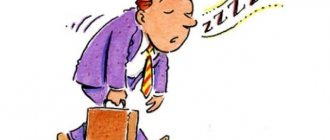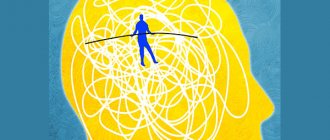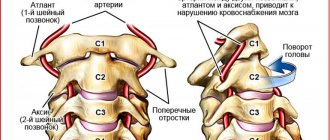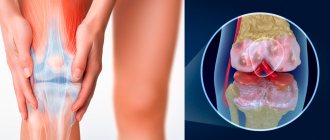Schizophrenia has many varieties. It is classified according to the rate of progression, characteristic symptoms, intensity of symptoms and other characteristics. In total, this pathology affects 0.5-1% of the population. One of its rare subtypes is hebephrenic schizophrenia. It is detected in 5% of patients with similar disorders. We will tell you what the features of hebephrenia are, how it arises, develops and is treated.
In this article
- History and main features
- Causes
- Symptoms
- Clinical cases
- Diagnostics
- Treatment
- Forecast
History and main features
The term “hebephrenic paraphrenia” was first used in 1871 by Ewald Hecker. In describing this disorder, he mentioned that it is “a special form of terminal dullness, the signs of which can be recognized in the early stages of the disease.” The pathology received its name in honor of the ancient Greek goddess of youth Hebe.
Today, the equivalent concepts of “hebephrenic schizophrenia”, “hebephrenic schizophrenia” and “hebephrenia” are used. You can also come across the term “schizophrenia of the disorganized type.” It is outdated, but in the literature you can still find the formulation “disorganized schizophrenia.”
The main feature of this disease is that the patient behaves like a child, even if he is an adult. In general, his behavior is inappropriate, foolish and mannered. Sometimes it is very ridiculous and obscene. The patient constantly giggles, smiles smugly, grimaces and plays pranks.
The onset of pathology usually occurs at 15-25 years of age. Residents of large cities often suffer from it. The incidence of development in women and men is approximately the same. The disease is not common. In its pure form, that is, without signs of other forms and types of schizophrenia, it is observed in only 5% of patients.
The schizophrenic defect in hebephrenia develops quickly, the pathology progresses rapidly, and is difficult to treat. There is a high probability that the patient will lose his purpose in life, and his existence will become meaningless.
Hebephrenic schizophrenia symptoms
- Age 14-18 years, sometimes later.
- Feeling of absence of thoughts.
- Marked regression of mental development:
- Disinhibited primitive behavior (foolish excitement, grimacing, mannerisms).
- Children's archaic speech, often with swear words.
- High mood, outbursts of aggression.
- Infantilism and non-compliance with social hierarchy.
- Unfocused, unconstructive activity.
- Hypersexuality (casual relationships, sexual perversions, exhibitionism).
- Increased appetite, possibly even eating inedible things.
- Sloppiness.
- Antisocial behavior.
- Marked disorganization of thinking: unproductive talkativeness, broken speech, devoid of content.
- Delusional and hallucinatory symptoms are rare and variable.
- Deficit in the emotional-volitional sphere.
- Rapid personality disintegration.
This form is quite rare in the general population of schizophrenia, but almost always leads to disability. Often patients become uncontrollable and dangerous to society, so early diagnosis is very important.
Differential diagnosis
This disease has a clear clinical picture, but the symptoms characteristic of schizophrenia in the form of delusions, hallucinations, loss of will and coldness of emotions are erased. Therefore, a thorough diagnosis, mandatory examination by a neurologist and long-term observation in a psychiatric clinic are required.
The picture of the disease is very similar to a number of neurological diseases: personality changes due to epilepsy, dementia, organic brain diseases (traumas, tumors and others). To exclude these conditions, a complete neurological examination is necessary, including EEG, EchoEG, CT, and NMR.
Causes
Doctors name several reasons that could hypothetically lead to or provoke hebephrenia:
- genetic abnormalities;
- fetal hypoxia;
- intrauterine infections;
- epilepsy;
- childhood psychological trauma.
These are predisposing factors. It is clear that it is difficult to call them direct culprits, since their presence only increases the risk of developing the hebephrenic form of schizophrenia. The impetus for the appearance of the first signs may be:
- child abuse;
- unhealthy atmosphere in the family;
- constant stress;
- bullying at school;
- brain diseases of various etiologies;
- alcohol and drug use.
Medical practice shows that patients with hebephrenia in infancy have low weight, low intelligence and strong involuntary reactions to stimuli.
Also, children who are subsequently diagnosed with hebephrenic schizophrenia differ in:
- persistent antisocial characteristics;
- overly exemplary behavior;
- dependence on adults;
- increased sensitivity;
- lack of communication;
- reluctance to perform mental work;
- general lethargy and passivity.
In addition, patients with hebephrenia experience early sexual intercourse, problems with the law, and other antisocial behavior. They are prone to rebellion, disobedience, and drug and alcohol use. In other words, they behave deviantly.
Peculiarities of behavior of patients with hebephrenic schizophrenia
Behavior changes quickly in such patients - this is the main symptom of hebephrenia. Patients are prone to impulsive, impetuous actions, chaotic activities, and absurd behavior. Patients change their place of stay, their place of activity.
Behavior is made up of movements, not actions. It becomes mannered, bizarre, grotesque, clingy, cocky, childish, stupid. There is paramimia (facial expressions do not correspond to the circumstances and emotions of the patient) and parathymia (inadequate mood), the desire to follow rituals, and mimicking others. The patient is active, but the activity is unconstructive and unfocused. By influencing the patient with persistent orders, you can distract him from meaningless actions, but the effect will be short-lived.
Patients with hebephrenia have high sexual activity (sexual perversions, casual relationships). Women use diminutive words, absurd coquetry, lisping, and possible manifestations of exhibitionism and flirting. Such patients are sloppy, do not take care of themselves, neglect hygiene, are prone to dromomania (vagrancy), and are easily offended. Selective communication, increased appetite. Inadequacy of emotional reactions, fluctuations in their intensity. Elevated mood with incomprehensible and strange humor, flat jokes. Unreasonable laughter can give way to crying for no reason.
| | Learn more about the negative symptoms of schizophrenia |
In the hebephrenic form, speech and thinking are impaired. Speech includes neologisms, is incoherent, and does not correspond to experiences. The speech contains careless and incorrect connections of sentences, and logical structures are violated. Patients confuse long periods and cannot put their thoughts in order. Tendency to use the same phrases and expressions (stereotyping), special jargon, foreign or uncommon words. In both written and spoken language, patients resort to a series of meaningless and pompous words or to cynical expressions with poetic and sentimental outpourings.
This also includes theatrical poses, pathos, a tendency to use diminutive names, distorted pronunciation (baby talk), burr, and an artificial lisp.
Symptoms
The onset of the disease is difficult to distinguish from bad or ill-mannered behavior. The patient is fooling around, making faces and saying stupid things. But outsiders should be wary of the complete lack of logic in his words and actions. He also often complains of various illnesses, which indicates hypochondria. Sometimes a person can be aggressive. In general, his mood is excessively elevated, but is often replaced by apathy.
The main symptoms of hebephrenic schizophrenia:
- Disorganized thinking. The patient cannot formulate and logically justify his thoughts. Because of this, he jumps from one topic to another, without being able to stop at one thing. In some cases, his speech is so confused and incomprehensible that others perceive it as a set of sounds.
- Disorganized behavior. A patient with hebephrenia may constantly make some movements, as if he has nowhere to put his hands. He puts them behind his head, straightens his socks, scratches himself, knocks on the table with his fingers, etc. In severe cases, he is unable to perform ordinary everyday activities - wash, shave, get dressed. Some patients behave childishly and stupidly, but sometimes they behave aggressively.
- Sexual deviation. We are talking about displaying genitals and defecating in public places. Also, patients with hebephrenia love to joke obscenely, and at the level of an eighth-grader who giggles in biology lessons. In general, the sexual topic is of great interest to the patient, like any child during puberty.
- Inadequacy of emotions. The patient can be either overexcited or extremely apathetic. Sometimes his face shows no emotion at all, as if he feels nothing. But at the same time, at any moment he can laugh out loud, and in any place, for example, in a lesson or an important event.
- Misconceptions With hebephrenic schizophrenia, a person may be at the mercy of false beliefs that are formed as delusions. It seems to him that he is a great person or that someone is constantly chasing him.
- Self-isolation. Gradually the number of contacts with people is reduced. The patient interacts less and less with others, including loved ones. It is not only the lack of interest on the part of the patient that interferes, but also poor social skills.
- Unawareness. In this case, we are talking about the fact that the patient does not consider himself sick. At the same time, he can easily explain his condition or stay in the clinic: “my parents wanted it,” “the doctor advised me,” “the pills are making me a fool,” etc.
Most often, relatives of the patient turn to doctors, since the latter considers himself “normal.”
Delusions and hallucinations, which are typical signs of almost any schizophrenia, may be absent in hebephrenia.
In severe forms, catatonic and manic syndromes, delusions, hallucinations and severe hypochondria are observed. Symptoms such as depersonalization and derealization may be recorded, when the world around us seems unreal. Foolishness gives way to apathy, speech becomes more and more meager and primitive over time. Some patients become very interested in religion, philosophy, or a narrower topic, for example, the work of the subway.
Main symptoms
Hebephrenia is, first of all, disorganized behavior of the patient. By the way, this disease was previously called “disorganized schizophrenia.” It is characterized by the fact that a person experiences a loss of control over his own emotions, movements, and actions. Sometimes they simply do not make sense; they are performed spontaneously and out of place.
Hebephrenic schizophrenia, compared to other types of disease, is a rather rare phenomenon. In addition, the main signs of a mental disorder of this type - hallucinations and delusions - are very rarely present in the anamnesis, but they are replaced by other symptoms. Violations of the following qualities and skills are observed:
- thinking. Personality degradation occurs. An adult begins to behave like a capricious, disobedient child. Intellectual indicators decrease;
- self-organization. Inability to plan one's own behavior. Problems with personal hygiene;
- logics. Sometimes it is very difficult to explain for what purpose certain actions were carried out;
- determination. There is chaotic execution of any actions;
- emotional background. It noticeably becomes poorer and seems to smooth out. The patient looks distant and uninterested.
At first glance, a person with hebephrenic schizophrenia has symptoms that could be mistaken, for example, for depression. However, serenity and calm are abruptly replaced by attacks of sudden rage, aggression, crying or laughter. It looks extremely unnatural. The motivation for actions is lost, and since there is no goal, behavior is impulsive and completely unpredictable.
The person looks infantile, imitating the behavior of a child. He may constantly complain that he is being beaten, offended, humiliated, although in reality this does not happen. At the same time, the conversation often contains obscene language, gestures, obscene jokes, grimaces, mixed with incoherent speech or laughter.
The patient may indicate strange sensations in specific parts of the body. At the same time, he clearly explains the cause and place of these experiences, for example: a light bulb is burning in the stomach, the legs are separated from the body and placed next to them, needles are stuck into the eyes, etc. For a healthy person, such explanations do not carry any semantic load, while the doctor takes them into account when making a diagnosis.
Clinical cases
With hebephrenic schizophrenia, the patient does not feel shame, he has no sense of responsibility or caution. He may behave defiantly, ask tactless questions without expecting an answer, giggle and use foul language. Almost constantly, such patients laugh at their own jokes. Moreover, their laughter seems unnatural, childish, feigned.
A typical example is the development of hebephrenia in a 14-year-old teenager. Until this age, he was diligent and obedient, studied well, and was raised in a complete family without relatives with mental disorders. During puberty, behavior deteriorated.
The patient stopped attending school, wandered around the city, undressed and pestered passers-by, began to smoke and drink alcohol. He categorically refused hygiene procedures, was often rude, showed his genitals to others, and attempted to defecate in the middle of the room. He was forcibly hospitalized.
Another example is a 19-year-old boy. I was admitted to the clinic with the typical symptoms of hebephrenia described earlier. During conversations with the doctor, he constantly made faces and periodically inserted obscene jokes into his speech. In general, I reasoned relatively normally. He remembered the dates and talked enthusiastically about the metro system. When I tried to remember all the stations, I got confused. The doctor tried to change the conversation to another topic, but the patient showed signs of aggression.
The patient believed that the state paid him a very small disability benefit, and the pills made him “a fool.” During the conversation with the doctor, he always moved his hands and fidgeted in place. Demonstrated the behavior of a 10-year-old child. To the question “why is he in the clinic?” answered that he was “crazy.”
The third example is a 16-year-old teenager. He was raised by his mother, and a very suspicious woman. One of the relatives was treated in a psychiatric clinic. He developed normally until the age of 12. He showed success at school, was distinguished by curiosity, and had good characteristics.
However, the teenager suddenly became rude and disobedient. At the age of 14, I began to develop very quickly physically. Signs of sexual deviation appeared. He began to consider himself a freak, made faces in front of the mirror for a long time, and became addicted to gambling.
Over time, he became more and more undisciplined, hypochondria developed - he forbade his mother to touch food, as he was afraid of infection. He was hospitalized at the age of 16 from the street when he was walking around naked.
Clinical picture
Hebephrenic schizophrenia begins to show its signs somewhere towards the end of adolescence. That is, until approximately 16–17 years of age, the child grew and developed normally, but at some point a sharp change in his behavior occurs. During this period, the formation of the adolescent’s psyche is completed, but a failure occurs, and instead of the development and final formation of a mature personality, its degradation occurs.
The main manifestation of the disease is the presence of inappropriate, antisocial behavior of a teenager, directed at classmates, teachers and even strangers. At first, these signs are attributed to a difficult age and are not given due importance. And only after a certain time, you can understand that in reality there is something wrong with the child. The strangeness of his behavior becomes obvious and catches the eye not only of his parents, but also of those around him.
There may be isolation, a limited social circle, or complete voluntary isolation from society.
In general, in the presence of hebephrenic schizophrenia, the following clinical picture is observed:
- a person cannot explain the reason for his own inappropriate actions;
- addiction to bad habits (smoking, alcohol, theft, etc.);
- conflict, manifestation of aggression towards others;
- clarification of relations through assault;
- inability to concentrate on a specific subject for a long time;
- losing the thread of conversation, abruptly jumping from one topic to another.
Hebephrenic schizophrenia deprives a person of a sense of shame, restraint, and caution.
He may ask tactless questions without waiting for an answer. The use of obscene words occurs as if in jest, but when pulled back, the patient deliberately repeats them and begins to behave even more impudently and defiantly. A person with obvious signs of hebephrenia can come up with words himself, repeat them many times, laugh at what he thinks is his own wit. Often such actions are accompanied by unnatural, feigned facial expressions. There is a feeling that he does not know where to put his own hands.
A special theme is preoccupation with the opposite sex. All patients experience increased sexuality. However, when talking about intimate topics, they begin to giggle and grimace, like an eighth grader in an anatomy lesson. Behind all this ostentatious gaiety and foolishness lies indifference to the world around us and spiritual emptiness.
Diagnostics
To accurately diagnose hebephrenic schizophrenia, you will have to observe the patient in a hospital for several weeks or months, depending on the condition for which the patient was hospitalized. As a rule, the question of hebephrenia arises when the foolishness does not go away within a month from the first day of observation. The following criteria are also used:
- there are no obvious delusions or hallucinations;
- there is a speech disorder;
- there are signs of mindless behavior.
It is important to carry out differential diagnosis. First, tumors of the frontal lobes of the brain, infectious inflammation, dementia due to Pick's disease (atrophy of brain structures) and Huntington's chorea (a disease of the nervous system) should be excluded. For this purpose, CT, MRI, EEG and fundus examination are prescribed.
If schizophrenia is suspected, the medical histories of relatives are always checked, since this pathology is often genetically determined.
Secondly, it is necessary to differentiate hebephrenic schizophrenia from hebephrenic syndrome, which can develop both within schizophrenia and as a separate disease against the background of epilepsy. The syndrome occurs with hallucinations, delusions and catatonia, and is also characterized by the following symptoms:
- contraction of facial muscles, grimacing;
- lack of motives in actions;
- causeless euphoria, elation.
The syndrome can lead to the development of schizophrenia or occur against its background, but this is not necessary. It all depends on how early treatment began.
Thirdly, it is necessary to distinguish hebephrenia from heboid psychopathy, which has similar symptoms, but occurs in a milder form.
Adolescent schizophrenia
7. Adolescent schizophrenia. The prevalence is approximately 10% of all cases of schizophrenia, it is more common in girls, and in 40–45% of patients it leads to disability (as in adult patients). In more than half of the girls, schizophrenia has a paroxysmal course, in 25% of cases it has a continuous progressive course (with onset in 10–13% of patients in childhood and the formation of an oligophrenia-like defect), in 20% there is a sluggish course. In boys, a paroxysmal course is observed in 20% of cases, in more than a third of cases a continuously progressive course is detected (in 12.8% with the formation of an oligophrenia-like defect), in almost half there is a sluggish course. There are no gender differences in the grossly destructive forms of the schizophrenic process.
The following main variants of schizophrenic conditions in adolescents differ (Tiganov A.S., 2012).
1) Conditions characterizing distant stages of the schizophrenic process. Diagnosed in approximately 30% of patients. This:
- post-processual states after early childhood seizures. The mental status shows features of a severe schizophrenic defect with monotony of affect, autism, low productivity of thinking;
- childhood malignant schizophrenia. Characterized by the predominance of a continuous course, the presence of an oligophrenia-like defect, as well as frequent hospitalizations (12–13% of all cases of the disease);
- early-onset low-progressive schizophrenia. It often occurs under the guise of the consequences of organic damage to the central nervous system, mononeuroses, and psychosomatic diseases. In adolescents, predominantly relatively mild non-psychotic symptoms are detected, existing against the background of a distinct schizophrenic defect (emotional impoverishment, decreased mental activity, signs of mental retardation, increasing loss of mental productivity and social isolation).
2) Schizophrenic psychoses with onset immediately in prepubertal and pubertal age. More often (41–42%) there is an onset of a sluggish progressive course (coded as schizotypal personality disorder), a paroxysmal course (in less than 30%, including 7.7% with schizoaffective attacks), much less frequently continuous paranoid schizophrenia is observed.
3) Erased schizophrenic (schizoform) conditions with an undeveloped clinical picture. Presumably, in such cases, there is predominantly an initial stage of schizophrenia with polymorphic symptoms, which are represented by: 1) deepening schizoid character traits; 2) autochthonous affective lability; 3) paradoxical and inappropriate reactions; 4) transient psychotic microsymptoms; 5) slowly increasing isolation and self-isolation; 6) emotional impoverishment and 7) decreased energy potential. Reliable diagnosis in most cases is possible only through a follow-up study.
4) Sluggish schizophrenia (schizotypal disorder) is observed relatively rarely in adolescents. Ideas of physical deformity are typical, which gradually transform into hypochondriacal delirium. There are also cases with hallucinations and persecutory delusions, which, in comparison with adult patients, are less likely to be systematized. As the disease progresses, the circle of perceptual deceptions and delusional phenomena expands, and symptoms of mental automatism appear. The schizophrenic defect is growing rapidly. Malignant (“nuclear”) schizophrenia may occur in adolescence.
5) Paroxysmal schizophrenia manifests itself and proceeds generally in the same way as in adult patients. Typologically, manifest psychoses are represented by affective-delusional, hallucinatory-delusional, polymorphic and much less often paraphrenic and oneiric-catatonic syndromes. At the same time, at the age of 17–18 years, polymorphic, affective-delusional and oneiric-catatonic attacks are more common; in adolescents aged 15–16 years, hallucinatory-delusional and undeveloped psychotic states are more common. The symptoms of attacks are characterized by great polymorphism, syndromic incompleteness, and the absence of a strict pattern in the development of acute conditions and their reverse development. In addition, the relative short duration of states of psychomotor agitation and confusion is noted. Adolescent paroxysmal schizophrenia does not seem to show any significant gender differences.
6) Schizophrenia, occurring in the form of an atypical protracted pubertal crisis. This refers to schizophrenia, especially slowly progressing, which is manifested mainly by such disorders as heboid syndrome, juvenile metaphysical intoxication, juvenile asthenic incompetence, dysmorphophobia, psychasthenic-like and juvenile sensitive delusions of attitude (Tsutsulkovskaya M.Ya., Panteleeva G.P., 1986; and etc.).
Diagnostic guidelines for this pathology, developed by a number of domestic researchers (Nadzharov R.A., Sternberg E.Ya., 1975; etc.), are presented as follows:
- the proximity of symptoms to the picture of exaggerated manifestations of pubertal crisis;
- the presence of bipolar affective disorders, often becoming continuous;
- development of an attack during puberty crisis;
- protracted nature of the flow;
- slow recovery from an attack with a complete reduction of psychopathological disorders at the end of adolescence;
- the formation of stable remission with a high level of social and labor adaptation in the presence of certain signs of post-processual personality changes, such as mental juvenileism, deepening of the schizoid personality type, some emotional leveling, rigidity.
The stereotype of the development of the process coincides with the stages of development of normal maturation.
1. Initial period. Begins at the age of 12–15 years. It is characterized by: 1) sharpening of character traits; 2) autochthonous atypical bipolar mood disorders (the presence of dysphoric overtones and dissatisfaction with oneself in depression or agitation with unproductivity and lack of desire to communicate - in hypomania); 3) opposition to the environment, conflict. There may be overvalued dysmorphophobia, pathological reflection with a feeling of change in one’s physical and mental “I”, abstraction of interests, and difficulties in contacts with others.
2. Manifest period. Corresponds to the age of 16–20 years, at this time the mental disorders mentioned at the beginning of paragraph 6, growing rapidly, are most acute. There are also such deviations as onirism (hypnagogic hallucinosis), other sleep disorders, appetite disorders, ideational disorders (in particular, inhibition of thinking, amorphous thinking, mentism, sperrungi), reflex and other hallucinations, individual hallucinations of the imagination, obsessive-phobic disorders, disturbances of self-perception, senesthopathy, hypochondria, etc. The condition remains more or less stable for a number of years or is interspersed with periods of remission, in which psychopathic, overvalued and affective disorders persist.
Depending on the predominant symptoms, there are 5 relatively independent clinical variants of atypical pubertal schizophrenic attacks:
- heboid attack. His manifesto is characterized by a pathological exaggeration and modification to a psychotic level of pubertal properties with a predominance of emotional and volitional disorders, including drives, as well as maladaptive behavior in violation of moral and social norms (rudeness, hostility, aggressiveness, cruelty, cynicism, loss of prosocial motivation and marginalization, negativity attitude towards life values accepted in society, sexual disinhibition, a tendency towards promiscuity and other sexual deviations, sloppiness, untidiness, etc.);
- attack with the syndrome of youthful metaphysical intoxication (Ziehen Th., 1924). During the period of the manifesto, according to V.V. Kovalev (1979), a syndrome of overvalued interests (an obsessive and unproductive passion for abstract issues: philosophy, logic, psychology, the search for the final cause of being, etc.) or an equally one-sided passion for certain activities (fanatical desire for physical or spiritual perfection, immersion in mysticism, esotericism, occultism, religion, etc.).
Thus, an 18-year-old patient has been “hardening himself” for the last 2 years, preparing his body for extreme tests. He runs for a long time in the cold in only swimming trunks, eats grass, insects and mice, sleeps on the wall in a device he made himself, starves, overeats, experiments with various diets, etc. He intends to live 300 years and laments that he started training late , I missed a lot of time. At the same time, pressing problems (study, interpersonal relationships, caring for loved ones, illness, etc.) remain unattended or in the background. It is characteristic that a passion for complex issues usually reveals a decrease in intellectual productivity, sometimes a loss of the ability to master the school curriculum to its minimum extent;
- attack with symptoms of juvenile asthenic incompetence (Glatzel J., Huber G., 1968; etc.). The main thing in this state during the period of manifestation is considered to be the dominance of peculiar cognitive impairments, leading to difficulties in perceiving and understanding information, in particular educational material, and therefore failure to study occurs. Cognitive disorders, in turn, are caused by depressive inhibition of thinking and intelligence, apathy, loss of curiosity and loss of mental initiative, neuropsychic exhaustion, especially pronounced during mental stress. The decline of mental activity is subjectively perceived as “intellectual dullness” and is usually difficult to experience, leading to attempts to somehow overcome it or at least mitigate it. For example, taking psychostimulants, doing heavy physical labor, hardening, studying with cognitive psychologists;
- attack with dysmorphophobic and psychasthenic-like disorders. Dysmorphophobia (Morselli E., 1886) is a pathological condition in which obsessive, overvalued or delusional ideas of a physical disability dominate. Psychasthenic-like disorder, according to G.P. Panteleeva (1965), are characterized by indecision, uncertainty in one’s actions and actions, expressed to a painful degree and disrupting social adaptation, embarrassment, vulnerability, sensitive ideas of relationship (described long before psychiatrists by F.M. Dostoevsky), focus on oneself, and not on problems to be solved. In other words, behind the phenomena of psychasthenia lies an overvalued “inferiority complex” (A. Adler), which is often complemented by hypercompensatory behavior;
- attack with juvenile sensitive delusions of relation. It is characterized by the dominance in the clinical structure of the primary delusion of “moral deformity”, “bad conscience” (Scharfetter Ch., 1976), which is complicated by delusional ideas of attitude and which occurs against the background of depressive mood disorder (Kretschmer E., 1966). Typical, as with any delusion, is inappropriate, delusional behavior, in particular aggressive and/or auto-aggressive behavior.
3. Period of convalescence. Occurs between 20 and 25 years. There is a gradual reduction of productive disorders up to their complete disappearance, compensation for relatively shallow deficiency symptoms, social and labor adaptation is restored, and professional growth of patients is possible.
4. Residual period. Only some patients experience persistent negative symptoms, such as loss of breadth of interests, decreased mental activity, purely rationalized by attitude towards loved ones, some isolation in the family circle, and the need for care from others. At the same time, in some patients, signs of infantilism come to the fore (impracticality, dependence on loved ones, emotional immaturity and weak drives with a good level of mental productivity), in others, schizoid personality traits prevail (autism, eccentricity), which do not, however, interfere with professional growth and successful social adaptation.
Return to Contents
Treatment
Therapy includes three areas: relief of symptoms, stabilization of the condition and prolongation of remission. To get rid of symptoms, the patient is prescribed antipsychotics and other drugs. In extreme cases, insulin comatose therapy is carried out, based on the artificial introduction of a person into a hypoglycemic coma.
Stabilizing treatment of hebephrenic schizophrenia is aimed at consolidating the result after relief therapy. For this purpose, antipsychotic drugs are prescribed in minimal dosages. If there is a catatonic syndrome, large doses of tranquilizers are administered intravenously.
The patient is in the hospital during treatment. Subsequently, he may be discharged, but he will have to take antipsychotics constantly. The patient status remains forever. The main task is to prolong remission. Individual work continues with the person. He sees a psychotherapist and sometimes goes to group sessions. Nursing care is important. Specially trained caregivers and nurses care for such patients.
At the same time, conversations are held with relatives, who need to be taught how to properly communicate with a schizophrenic. The problem is that any factor, even a minor one, can provoke a new attack, for example, a minor quarrel, conflict between spouses, divorce, etc.
In general, after successful therapy, the following effects can be achieved:
- prolongation of remission;
- increased performance;
- return of interests;
- reduction of aggression;
- improving quality of life.
If necessary, the doctor lowers or increases the dose of the drug.
Treatment of hebephrenic schizophrenia
Basic treatment methods
- Neuroleptics;
- Electroconvulsive therapy;
- Since it is almost impossible to force such patients to take medications at home, long-term antipsychotics are necessarily prescribed upon discharge from the hospital. And also mood stabilizers - to correct behavior and mood swings.
Treatment takes place in a psychiatric hospital, since the behavior of patients is often socially unacceptable, they cannot care for themselves, and there is a high risk of suicide or aggressive behavior.
The Transfiguration Clinic will always help
Psychiatrists at the private clinic “Preobrazhenie” were able to achieve great success in the treatment of hebephrenic schizophrenia.
Advantages of the clinic
- We use modern, new generation drugs.
- We use only original drugs (not cheap substitutes).
- Experience and professionalism of our staff.
- Availability of contacts with leading scientific medical institutes around the world.
- Continuous professional development of employees.
- The individual characteristics of the formation of the organism are taken into account.
- We use our own psychotherapeutic techniques.
- We guarantee complete anonymity.
- Comprehensive examination and round-the-clock medical assistance.
You can contact the clinic’s specialists by phone in Moscow.
Forecast
The prognosis for hebephrenic schizophrenia is disappointing. The chances of a positive outcome are minimal. In addition, this pathology develops rapidly. Treatment usually begins when the patient is at the stage of severe exacerbation.
The patient should be shown to a specialist much earlier - when the first changes in behavior appear, especially in cases where there is a serious contrast. So, if a teenager was always obedient and studied well, but suddenly began to be rude to everyone and neglect his studies, it is recommended to at least consult a psychologist.
However, even when treated at an early stage of the disease, the effect is often temporary. It becomes increasingly difficult for the patient to control outbursts of anger. He gradually withdraws into himself and loses touch with the outside world. 2-3 years after the onset of the disease, an irreversible defect in emotional and volitional qualities occurs. It is necessary to isolate a person from society forever, since he poses a danger to himself and others.
In fact, the only thing that can be done is to maintain the remission phase for as long as possible. But in most cases, relapse cannot be avoided, since the pathology leads to serious destruction of the brain. In this case, the second exacerbation will be more severe than the first.
Descriptions by various authors
In the works of Pyotr Borisovich Gannushkin on constitutional psychopathy, an analogue of dissocial personality disorder is “ antisocial psychopathy.”
»[10].
Doctor of Philosophy in Experimental Psychology, renowned researcher in the field of criminal psychology, Robert D. Hare (English) Russian. uses the word “ psychopath”
” to refer to people with this type of personality disorder[11].
McWilliams
In the works of Nancy McWilliams, dissocial personality disorder is described within the framework of the concept of “ psychopathic personality”
" and its synonym "
antisocial personality
". McWilliams describes this personality disorder as being based on a deep-seated inability (or severely impaired ability) to form attachments to other people, including one's own parents and children. From her point of view, a sociopath does not see attachments between other people and interprets their relationships solely as mutual manipulation. In accordance with his perception of society, a sociopath builds his relationships with people around him: on manipulation, for the sake of satisfying his own desires. Since a sociopath has no attachments, other people's needs and desires have no value for him and he acts based only on his own. Since he doesn't expect anyone to consider his own needs, the only long-term plan he can make for safe coexistence with society is to "get everyone to listen to him." The sociopath expects the same from those around him and, as a result, does not see the long-term benefit of observing social norms, including legally established ones: social norms and moral norms are perceived by the antisocial psychopath as a means of coercion and manipulation. Sociopaths have no qualms about lying and committing illegal acts. In most cases, they are driven by their own benefit/disadvantage, but only in the short term. They act impulsively and are not prone to planning. They take restrictions on freedom and the fulfillment of their desires seriously; they try to prevent this using methods available to them, mainly through threats or the use of physical force. Refusal to use force is perceived as weakness. They can make an extremely positive impression for some time in order to later use it to their advantage. They do not experience remorse, or rather, do not have a conscience or have it in an extremely underdeveloped form (the development of conscience is directly related to the formation of a sense of attachment).
It is important to understand that such people fully “understand” social norms, but ignore them. They are able to interact with society according to its rules, but do not feel the need to do so and have poor control over their own impulsiveness[12].
Eric Bern
Main source: Bern E. Introduction to psychiatry and psychoanalysis for the uninitiated. — Minsk, 1998
According to Eric Berne's definition, there are two types of sociopaths:
- The first type, the latent
or
passive sociopath
, behaves quite well most of the time, accepting the guidance of some external authority, such as religion or law, or becoming attached at times to some stronger personality, considered as an ideal (we are not talking about those who use religion or law to guide their conscience, and those who use such doctrines instead of conscience). These people are not guided by ordinary considerations of decency and humanity, but are simply obeying their accepted interpretation of what is written in the “book.” - The second type is an active sociopath
. It is devoid of both internal and external restraints. Even if he can pacify himself for a while and put on a mask of integrity (especially in the presence of people who expect decent and responsible behavior from him), but as soon as such sociopaths find themselves beyond the reach of individuals who are authoritative for them and require good behavior, they immediately cease to restrain themselves.
Typical types of deviant behavior in sociopathy may include:
- directly criminal - sexual attacks on people, murders for hooligan reasons or fraud;
- not formally punishable, but condemned by society - inappropriate behavior of drivers on the road, deliberate evasion of duties at work, minor dirty tricks on others. “Non-criminal” sociopaths, however, do not care about the danger or extra work that they will incur on other people, and are indifferent to their possible losses.
Complications
The consequences of hebephrenic schizophrenia can be of two types. The first is the collapse of personality and withdrawal into oneself. A person's life loses any meaning. This option is described above.
The second group of complications is associated with the period of development of pathology before hospitalization. Due to hypersexuality, irresponsibility and aggressiveness of the patient, as well as due to the lack of a sense of shame, the following scenarios are possible:
- violation of the law (theft, sexual violence, etc.);
- alcohol abuse and drug use;
- dismissal from work, expulsion from the institute;
- promiscuous sexual intercourse;
- suicide attempts.
Convincing a patient to see a psychotherapist is quite difficult. Experts advise involving people who are an authority for the child. Perhaps he will listen to them. If there are none, call a doctor at home. Experienced doctors know how to persuade such patients to undergo examination. Otherwise, a person is forcibly hospitalized after committing a crime or attempting suicide.
We need your bestial morality - from lantern to lantern!
Or, to use poetic language: fly wherever the wind of passion blows.
Passion is almost material due to its tangible reality. A feature of this pathology, also called “moral insanity” in psychiatric works, is a gross disregard for existing social moral norms for the sake of one’s ego.
A striking illustration of the behavior and life of a heboid is the hippie movement that swept America in the recent past.
Adults, only outwardly young boys and girls, suddenly left their homes (for the most part, the homes of wealthy parents) to indulge in all kinds of hard things - giving themselves up to vagrancy, theft, drug intoxication, indulge in unrestrained sex and brutal fights.
And this was not a herd of brainless cattle - many already had a university education and a prestigious job or its prospects.
The massive spread of the hip movement was led by the condemnation of parents who lead a lifestyle of either “wolves” or “lambs” that is equally hated by rebellious youth. “Your bestial morality is for us - from lantern to lantern!” - a line from Vysotsky, piercingly revealing the extent of this condemnation.
Heboid hippies did not offer anything in return for the already established way of life - they were driven solely by stubborn protest and intoxication with freedom, falsely understood as doing nothing, unbridled sex, spurred on by marijuana, and continuous self-affirmation among their own kind.
Meaningless transitions and moving from place to place are not at all the same as the search for a better life and happiness in a foreign land. No attempt is made to make money as a mattoid; everything is obtained exclusively through theft and disguised begging.
Due to the peculiarities of the psyche, which does not reach a mature level and does not allow one to see oneself with an unbiased look, and an unhealthy lifestyle, heboids become the worst enemies not only of society, which they blame for all their troubles, but also of themselves and their own kind.
Possessing a sufficiently developed mind and imagination, patients often satisfy their vanity by mentally playing out scenes of sadistic content, where parents are assigned the roles of victims. In some cases, they realize their subconscious intentions by mutilating and killing animals and mocking the defenseless and weak.
Hippies are bright representatives of mattoids:
According to the definition of French psychiatrists, heboid teenagers who have not run away from home and torment loved ones with their senseless antics are “home executioners.”
The end of the life of such individuals is often sad: having cut off all family ties, they are not able to create full-fledged families. Those who have not taken their own lives die from diseases of the AIDS category and the consequences of alcoholism, homo- and bisexuality, become prisoners in prisons and regulars in psychiatric clinics, because every next crime requires another examination - heboids do not go for voluntary treatment due to non-recognition of the flawed state of their psyche.









